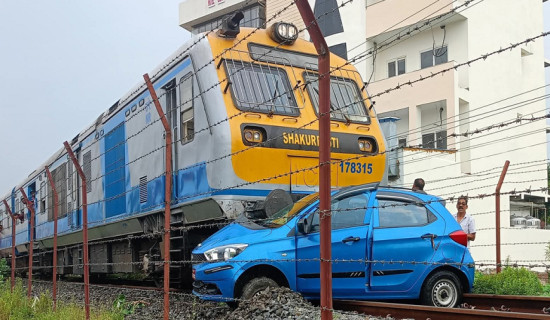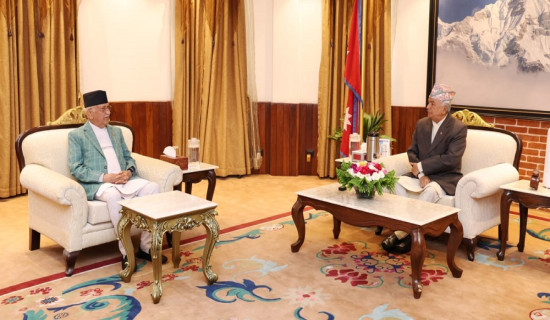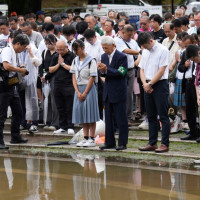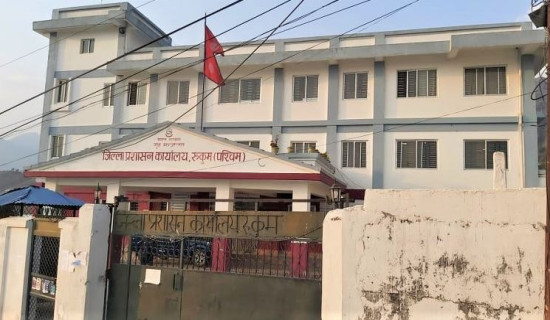- Sunday, 10 August 2025
Heritage at risk, traditional Kirati homes replaced by modern ones
By Our Correspondent,Dhankuta, Aug. 10: A small, neat, traditional Kirati-style house slightly elevated above the ground. Outside, there’s a porch (sikwa) with a neatly arranged wooden plank staircase leading to it. A small wall made of wood and mud encloses the porch. The roof is set just slightly above ground level. Inside, through the main door, one can see artistic carvings. Upon passing the porch and entering, there’s a fireplace, a beam above it for drying items, a bare kitchen corner, beds, drums, cymbals, traditional storage baskets, and clothes—creating an unusual, nostalgic atmosphere.
This scene depicts a traditional Kirati-style house located in Khokling, Ward No. 4, Shahidbhumi Rural Municipality, Dhankuta. It is reputed to be the oldest house in the rural municipality. The exact date of construction is unknown, but according to Buddhi Man Rai, the current owner, it has remained unchanged since his father's and grandfather’s time.
“It was just like this when I knew it, and my father and grandfather also said it was like this even before them,” he says. Based on his ancestors' accounts, Rai estimates the house could be at least 300 years old.
During the Papani festival celebrated in the Khalsa region, dances start from this very house due to its historic significance. Nearby, a more modern house has been built. Some family members still live in the old house, while others reside in the new one. Aside from repairs to the roof and walls, no structural modifications have been made to the traditional house, according to Chamari Rai, a relative of Buddhi Man.
Another similar traditional house is located in Ward No. 6 of the same rural municipality. Built in 1950 A.D, 92-year-old Ran Bahadur Rai still lives there with his family. He states, “Previously, the entire village used to build houses like this. Everyone would gather, collect materials, and construct the house together.” Today, most of these houses have been demolished, leaving only 4–5. Traditional Kirati-style houses, found across Dhankuta, Panchthar, Ilam, Bhojpur, Tehrathum, and Khotang, have gradually disappeared.
Although the outer appearance of Kirati houses varies regionally, their interior design and structure remain mostly similar, according to tourism expert Ramesh Rai “Gaunle.” However, recently, these old-style homes have been demolished across all regions.
These houses began to disappear as Dhankuta evolved into a market hub. While traditional houses were once common in Dhankuta and the surrounding areas, development prompted their replacement. Hanuman Dhoka Museum Chief Kaji Pyakurel mentioned that even respected community members began abandoning traditional styles for zinc-roofed and later concrete houses after observing modern structures in the growing market centre.
He stated that these houses in Dhankuta are among the oldest of their kind. Local resident Shanta Kumari Rai notes efforts are now underway to preserve the remaining houses. However, a lack of knowledge about their construction, the unavailability of traditional materials like thatch, and the younger generation’s disinterest have contributed to the decline of traditional Kirati homes.
Traditional homes built with local materials and techniques are now fading amid modernisation. Typical features include low roofs close to the ground, small porches, single rooms, fireplaces, and traditional storage areas. Shahidbhumi Rural Municipality Chairperson Manoj Rai said, "These Kirati-style houses, found in various regions, are being destroyed." He added that efforts are ongoing to conserve the remaining structures within the municipality. “Not many are left. Only a few houses remain. But these are not just homes – they are Kirati heritage. If not preserved, future generations will know them only as legends,” said Chairperson Rai.




-square-thumb.jpg)
-square-thumb.jpg)

-square-thumb.jpg)

-original-thumb.jpg)






